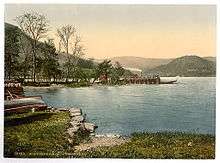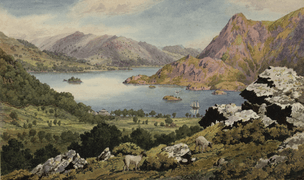Ullswater
| Ullswater | |
|---|---|
 Ullswater looking towards Silver Point. | |
| Location | Lake District, England |
| Coordinates | 54°34′39″N 2°52′30″W / 54.5775°N 2.8751°WCoordinates: 54°34′39″N 2°52′30″W / 54.5775°N 2.8751°W |
| Type | Ribbon lake |
| Basin countries | United Kingdom |
| Max. length | 11.8 km (7.3 mi)[1] |
| Max. width | 1.02 km (0.63 mi)[1] |
| Surface area | 8.9 km2 (3.4 sq mi)[1] |
| Average depth | 25.3 m (83 ft)[1] |
| Max. depth | 63 m (207 ft)[1] |
| Water volume | 223 x 106 m³[1] |
| Residence time | 350 days[1] |
| Surface elevation | 145 m (476 ft) |
| Settlements | Glenridding, Pooley Bridge |
| References | [1] |
Ullswater is the second largest lake in the English Lake District, being approximately nine miles (14.5 kilometres) long and 0.75 miles (1,200 m) wide with a maximum depth of slightly more than 60 metres (197 ft). Many regard Ullswater as the most beautiful of the English lakes;[2] it has been compared to Lake Lucerne in Switzerland and it is a popular tourist destination. It is a typical Lake District narrow "ribbon lake" formed after the last ice age when a glacier scooped out the valley floor and when the glacier retreated, the deepened section filled with meltwater which became a lake. A total of three separate glaciers formed the lake. The surrounding mountains give Ullswater the shape of a stretched 'Z' with three distinct segments (or 'reaches') that wend their way through the surrounding hills.
For much of its length Ullswater forms the border between the ancient counties of Cumberland and Westmorland.
Etymology
The origin of the name 'Ullswater' is uncertain. Whaley suggests 'Ulf's lake', from Old Norse personal name 'Ulfr' plus Middle English 'water' influenced in usage by Old Norse 'vatn' 'water', 'lake' ....'Ulfr' is also the Old Norse noun meaning 'wolf', and Hutchinson thought that the name might refer to the lake as a resort of wolves, or...to its elbow-shaped bend (citing a Celtic 'ulle'...)."[3]
Some say it comes from the name of a Nordic chief 'Ulf' who ruled over the area;[4] there was also a Saxon Lord of Greystoke called 'Ulphus' whose land bordered the lake. The lake may have been named Ulf's Water in honour of either of these, or it may be named after the Norse god Ullr. Hodgson Hill, an earthwork on the northeast shoreline of Ullswater may be the remains of a Viking fortified settlement.[5]
Settlements

The village of Glenridding, situated at the southern end of the lake, is popular with tourists of all kinds but especially with mountain walkers, who can scale England's third highest mountain, Helvellyn, and many other challenging peaks from there. The village has ample accommodation including two Youth Hostels and camp sites. The village of Pooley Bridge is at the northern extremity of the lake. Its narrow 16th-century bridge straddled the River Eamont as it flows out of Ullswater but was washed away during the floods that affected Cumbria in December 2015; it is overlooked by Dunmallard Hill, which was the site of an Iron Age fort. On the western side of the lake near Aira Force waterfall lies numerous accommodation sites, including the Brackenrigg Inn. Other villages situated on Ullswater include Howtown, Sandwick and Watermillock.
Sport, leisure and tourism


The lake has been a popular tourist destination since the mid-18th century. By the 1890s, Ullswater had become a fashionable holiday destination for the British aristocracy, thanks to its good sailing conditions and proximity to fell shooting estates. In 1912, Wilhelm II, German Emperor visited Ullswater and toured the lake on the MY Raven, which was re-fitted to act as a royal yacht.[6] A shooting lodge was constructed for the Kaiser at Martindale by the major local landowner, Hugh Lowther, 5th Earl of Lonsdale.
Ullswater's attractions include the Ullswater 'Steamers' which offer trips around the lake calling at Pooley Bridge, Glenridding, Howtown and Aira Force.[7] The 'Steamers' operate all year round and were originally working boats which from the 1850s moved mail, workers and goods to and from the Greenside Mine at Glenridding, which closed in 1962. Today there are five 'Steamers' plying the waters of Ullswater. People often catch the 'Steamer' from Glenridding to Howtown and then return on foot along the lake shore to complete one of the most popular and scenic low-level walks in the Lake District.
Ullswater is very popular as a sailing location, with several sailing marinas situated around the lake. Ullswater is home to the Ullswater Yacht Club and the prestigious Lord Birkett Memorial Trophy, which is held annually on the first weekend in July. This regularly attracts upwards of 200 sailing boats and comprises two races, both of which cover the full length of the lake. There are also facilities for diving, rowing and motorboats. Another of Ullswater's attractions is the waterfall of Aira Force, midway along the lake on the western side. Ullswater lies partly within the National Trust's Ullswater and Aira Force property. Close to the falls is Lyulph's Tower, a pele tower or castellated building built by a former Duke of Norfolk as a shooting box. The prestigious Sharrow Bay Country House hotel is located on the lake's eastern shore.
Donald Campbell set the world water speed record on Ullswater on July 23, 1955, when he piloted the jet-propelled hydroplane "Bluebird K7" to a speed of 202.32 mph (325.53 km/h).
In 2012, artist Robbie Wild Hudson swam the entire length of Ullswater. The swim, from Glenridding to Pooley Bridge, took 6 hours and was completed as inspiration for a project that offers paintings and drawings of the famous landscape from a different perspective.
Ullswater Yacht Club (UYC) is situated on the eastern shore of the lake between Pooley Bridge and Howtown. UYC also offers a sailing school program that is open to members of the general public.
Notable people
Just south of Pooley Bridge on the lake's eastern shore is Eusemere, where anti-slavery campaigner Thomas Clarkson (1760–1846) lived; the house gives one of the best views of the lower reach of Ullswater. William and Dorothy Wordsworth were friends of Clarkson and visited on many occasions. After visiting Clarkson in April 1802, Wordsworth was inspired to write the poem "Daffodils" after seeing daffodils growing on the shores of Ullswater on his journey back to Grasmere. Wordsworth once wrote of "Ullswater, as being, perhaps, upon the whole, the happiest combination of beauty and grandeur, which any of the Lakes affords".[8]
The politician William Marshall lived on the shore of Ullswater at Watermillock. His descendants, the diplomat Sir Cecil Spring Rice and his brother Stephen Spring Rice, were also brought up in Watermillock, and there are several memorials erected at nearby Aira Force to members of the Spring family.[9]
In 1962 Lord Birkett led the campaign to prevent Ullswater from becoming a reservoir. He died one day after the proposition was defeated in the House of Lords, and he is commemorated with a memorial plaque on Kailpot Crag.
Gallery
 Ullswater painted in 1825
Ullswater painted in 1825- Ullswater from Seldom Seen in Glencoynedale.
 Ullswater steamer SS Lady On the Lake leaves Glenridding
Ullswater steamer SS Lady On the Lake leaves Glenridding View south towards Patterdale
View south towards Patterdale
- Quicksilver 500 Pilothouse used by the Lake District National Park Authority
References
- 1 2 3 4 5 6 7 8 McNamara, Jane, Table of lake facts, Environment Agency of England and Wales, archived from the original on June 28, 2009, retrieved 2007-11-13
- ↑ www.ullswater.visitor-centre.co.uk. Calls Ullswater "England's most beautiful lake and so much more".
- ↑ Whaley, Diana (2006). A dictionary of Lake District place-names. Nottingham: English Place-Name Society. pp. lx,423 p.351. ISBN 0904889726.
- ↑ www.ullswater.visitor-centre.co.uk. Gives meaning of name as "Ulfs Water".
- ↑ The Hodgson Clan Website
- ↑ History of Ullswater 'Steamers' on the company website (accessed 25 July 2015).
- ↑ Ullswater 'Steamers' company website (accessed 25 July 2015).
- ↑ Wordsworth, William (1926). Wordsworth's Guide to the lakes (5th edition (1835), with an introduction, appendices, and notes textual and illustrative by Ernest de Selincourt ed.). London: Humphrey Milford. pp. xxxii, 203, p.14.
- ↑ http://www.visitcumbria.com/pen/aira-force/
External links
- Ullswater and Aira Force information at the National Trust
- Ullswater Yacht Club
- Ullswater 'Steamers'
- Lake District Desktops — Ullswater information and photographs.
- Ullswater Information, Photos and Events
- Lakeland Walks around Ullswater
- The Cumbria Directory - Ullswater
- Video footage of the Aira Force Pier in 2015.
- Video of the Glenridding to Glencoyne Bay walk
| Wikimedia Commons has media related to Ullswater. |